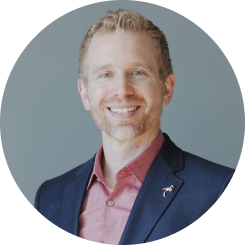The world of work looks a lot different these days. These experts and thought leaders are here to help you navigate the change, offering insights and tips for how you can better connect with colleagues and motivate teams.
13 Experts Provide Tips on Fostering Happiness at Work

- 01 Connect your workforce - Jumplink to Connect your workforce
- 02 Motivate and inspire people - Jumplink to Motivate and inspire people
- 03 Set workers up for success with the right processes and tools - Jumplink to Set workers up for success with the right processes and tools
- 04 Foster happiness and positive habits - Jumplink to Foster happiness and positive habits
- 05 Make work more human - Jumplink to Make work more human
These days, many of us are working from a mix of in-office and home environments. Digital interactions are now commonplace, with workers occasionally meeting in person under certain circumstances.
While this new, hybrid approach enables greater flexibility and autonomy for workers, there’s not exactly a rulebook for how to manage a team in this new environment, leaving leaders with more questions than answers:
- How do you unify and connect your distributed workforce?
- What does it mean to motivate and inspire your people?
- What new processes and tools are required to set workers up for success?
- How do you foster employee happiness and positive habits?
While there may not be just one right answer to these questions, there is a guiding principle: understand what makes your employees tick. At least, that’s what the experts say.
In this guide, we’ve gathered essential tips and insights from thought leaders, who all employ different methodologies around business culture, management, and communication in the workplace. By understanding who we are as humans and how to tap into our inner workings, these experts say, we can help enable effective collaboration, create positive habits, foster trust, and more. Here are their pointers:

Jay Van Bavel
Create team cohesion
Jay Van Bavel is a professor of psychology and neural science at New York University.
Broader connection isn’t as easily nurtured in this new hybrid environment, tasking leaders with finding new ways to bind us all together and build trust.
According to Jay Van Bavel, there’s a new mandate for leaders of a flexible workforce: create a sense of “us.” If we want to future-proof flexible work, we need to help workers transcend the individual identity that comes with working from home and plug into a group identity. This fosters collaboration and innovation.
- Establish shared goals where everyone is working together
- Use collective rewards that recognize all team members for success
- Share stories to affirm a communal sense of purpose
- Create symbols to align everyone as part of something bigger
- Establish social norms to guide inclusive behavior
- Act as “one of us” to inspire other people to follow your lead
Great organizations have healthy norms, so you need to think carefully about what these norms are, communicate them, and reward them.
Jay Van Bavel

Tessa West
Tessa West is an associate professor of psychology at New York University.
According to Tessa West, there are several ways to use video meetings to help everyone gain the contextual information that accompanies physical interaction, bridging the gap between at-home workers and in-office workers.
- Use as few screens as possible: If people are in a room together, ask them to use the same camera so there’s not a mix of input sources and you can focus on nonverbal communication between the people in the room.
- Create turn-taking rules and avoid speaker view: Setting rules helps increase inclusion and reduce the negative impact of people West calls “bulldozers,” who dominate conversations.
- Use chat strategically: Some may pay attention to only the chat rather than the speaker or vice versa, so be sure to deploy chat in a way that creates a consistent experience for all.
- Create in-person opportunities for newcomers: While leaders shouldn’t mandate when and how people engage in person, they should identify and foster natural opportunities for newcomers to physically interact with their teams.
- Prioritize time for networking: Regardless of in-person or remote status, every employee needs networking opportunities.
You have to create structures for remote workers to have those informal interactions and not just assume they’re going to reach out to people. There are just no water cooler conversations going on for people who work remotely.
Tessa West

Charlene Li
Charlene Li is an expert on digital transformation, leadership, and customer experience. Li was named one of the most creative people in business by Fast Company, and she is the author of six books, including her New York Times bestseller, Open Leadership.
These days, disruption is the norm. Learning how to survive — and even thrive — in the face of disruption is essential. To support both employees and customers during this time, Charlene Li claims today’s leaders must shift their organization’s culture to embrace disruption.
- Maintain openness: By continuously sharing information and fostering a transparent decision-making process, leaders can create trust and accountability.
- Sponsor agency in every employee: Help every employee understand what they can and can’t do — that way they don’t need to wait to know their own power.
- Have a bias for action: Decide what information you need to take action. Ask yourself, “In order for us to make a decision, what’s the one question we need to answer?”
The key thing here for you to realize is that to be a leader, you have to be creating change. Because if you’re not creating change, then you’re not a leader, you’re a manager — you’re managing to the status quo.
Charlene Li

Gretchen Rubin
Gretchen Rubin is an award-winning podcast host and New York Times bestselling author.
Your employees aren’t in one place anymore, which means it’s more important than ever to understand what motivates them. According to Gretchen Rubin, you can better understand yourself and others around you with a personality framework known as the “Four Tendencies.” Rubin’s framework is based on one question: how do you respond to expectations? How you react reflects one of four tendencies:
- The Upholder: Upholders readily fulfill both outer and inner expectations — they meet deadlines, are eager to know what people want from them, and expect a lot from themselves. They’re focused on execution and self-direction, which means they’re often perceived by others as rigid.
- The Questioner: Questioners will do something if it makes sense to them — they make everything an inner expectation. They resist arbitrary items and any perceived injustice, requiring reasons and rationale for doing anything.
- The Obliger: Obligers meet outer expectations but struggle to meet inner ones. They never fail to help others, but struggle to help themselves — which makes them great team members, friends, and family members. If they want to keep a form of inner expectation, they have to have a tangible form of outer reliability.
- The Rebel: Rebels resist both types of expectations and do things their way, on their time. They don’t even listen to themselves most of the time. Rebels place a high value on identity — they make decisions based on what feeds into their existing self-perception.
Just because a tool worked really well for your [co-worker] doesn’t mean that it’s going to work for you, and vice versa. We just have to understand those differences and respect them.
Gretchen Rubin

David Horsager
David Horsager is the CEO of Trust Edge Leadership Institute, a business strategist, keynote speaker, and author.
According to David Horsager, trust is the linchpin for a successful business strategy — leaders need to foster it before they can expect workers to embrace new processes and changes. In fact, research from The 2021 Trust Outlook reveals that the No. 1 reason people want to work somewhere is because they trust leadership. So how do you actually become trustworthy?
- Clarity: Be clear and avoid the ambiguous or overly complex.
- Compassion: Care beyond yourself.
- Character: Do what’s right over what’s easy.
- Competency: Stay fresh, relevant, and capable. Keep with the times, and be skilled.
- Commitment: Stay committed even in the face of adversity.
- Connection: Be willing and eager to collaborate with others.
- Contribution: Remain willing to help and show proven results.
- Consistency: Provide the same experience to everyone to foster a trusted reputation.
You think you have an innovation issue? The only way to increase innovation on a team is to increase trust so people will share ideas and get more creative.
David Horsager

Lauren Eskreis-Winkler
Lauren Eskreis-Winkler is an assistant professor at the Kellogg School of Management at Northwestern University.
According to Lauren Eskreis-Winkler, the secret to success isn’t talent or skill — it’s grit. Eskreis-Winkler has studied grit over the years, determining its connection to success and what people can do to cultivate it. She outlined three key ways you can become — or help others become — a grittier person:
- Prioritize practice via changing your beliefs: People lack grit because of lack of practice — either they don’t know how to practice or they believe they can’t. First and foremost, change your beliefs around practicing, and don’t let frustration or fear of failure stop you from pushing forward.
- Give advice to gain motivation: When someone procrastinates or fails at a task, it’s not usually because they lack the knowledge on how to complete it, it’s that they lack motivation. If you’re lacking the confidence you need to chart forward, fake it until you make it. Act like an expert, give advice to others, and remind yourself you have value to add.
- Cultivate a growth mindset: We can either have a growth or a fixed mindset. We believe capabilities are flexible and changeable, or innate and immovable. Our mindset has a tremendous impact on whether we persist — if you don’t believe change is possible, why would you try to change? By cultivating a growth mindset and a desire to learn, you lay the foundation for grit.
People think success looks like a straight arrow, and I think this is because often people who succeed overshare their successes. Success really looks like a squiggly line, no one really knows where they’re going and it’s rife with failure.
Lauren Eskreis-Winkler

Lindsay McGregor
Lindsay McGregor is the co-founder of Vega Factor and co-author of the bestselling book, Primed to Perform.
Motivation is a tricky topic, one that has leaders scratching their heads on how to master. According to Lindsay McGregor, motivation can be boiled down to a framework that leaders can apply to effectively inspire employees’ best work. Called “The Motive Spectrum,” this framework can be organized into two categories of motives: direct and indirect.
- Play: You love the activity involved in your work
- Purpose: You love the outcome of work, as it aligns with your identity, values, and beliefs
- Potential: You care about the eventual outcome of your work or see it as a stepping stone to get to a further goal
- Emotional: You feel pressure, external forces, or guilt to do something
- Economic: You feel financial pressure to work, or you do something to gain a reward or avoid a punishment
- Inertia: You do something because you’ve always done it
Certain parts of this motive spectrum can result in either one of the two performance types that McGregor identified: tactical and adaptive.
- Tactical: Follow best practices, stick to plans, adhere to instructions
- Adaptive: Create a better practice; focus on creativity, innovation, and problem-solving
You can get tactical performance through both indirect and direct motives, but you only get adaptive performance from direct motives.
Take a moment to think about what’s the ‘play’ or ‘purpose’ reason for doing something. ‘Play,’ meaning what’s going to be interesting to learn in the process of doing this, and ‘purpose,’ meaning what’s the impact of doing this. Once that becomes second nature, it becomes hugely transformative.
Lindsay McGregor

Mark Bowden
Mark Bowden is a world-renowned body language expert, keynote speaker, and bestselling author. He is the founder and president of TRUTHPLANE.
Work happens everywhere: home, the office, airports, coffee shops — you name it. To stay connected with colleagues and customers, regardless of location, you need to master the art of hybrid collaboration. Mark Bowden provided 12 tips and tricks on how you can make the most of your hybrid meetings:
- Build bite-sized content: You need to create short moments, chunks of content that hold your audience’s interest.
- Encourage active participation: Create a welcoming environment and enrich your content with stimulating visuals and persistent engagement opportunities.
- Keep it conversational: Try to find a partner with whom you can interact with during the meeting, opening up a dialogue that helps make the experience feel informal and comfortable.
- Create connection through eye contact: Move the camera up to eye level, lean forward, and bring your gestures into the frame.
- Let your background speak to who you are: Tailor your environment to reflect your passions and interests, showing personal photos or favorite objects.
- Establish clear, reliable audio: Test how comfortably you can be heard, and if your sound is lacking, equip yourself with an external mic and earpiece, as well as a stable internet connection to protect the sound quality.
- Be comfortable with silence: By embracing silence, you create a safe space for others to provide comments or questions, fostering a more engaging dialogue overall.
- Use your resources wisely: Set up an environment that respects and involves the virtual environment more — start by putting in signs and physical reminders to look at the camera more.
- Adjust mannerisms and tone accordingly: Tailor your mannerisms and tone to make sure no participant feels left behind. You can animate your actions to better engage remote participants, while also calming your tone for when you speak in person.
- Keep checking in: Regulate meetings by keeping an eye out for gestures that suggest sentiment, as these help participants express their needs and give them space to jump in.
- Expand the visual: While you can’t force anyone to turn their camera on, you can remind meeting attendees that the environment is more engaging and inclusive with the extra visual.
- Be an advocate: Be intentional about involving remote attendees and advocate on their behalf during the call so they feel empowered to speak up.
Don’t fear the silence [in a meeting]. It takes time for people to compute and come back with an answer. By taking the time to let your audience respond, you can find out what’s really going on with people across the planet in real-time — it’s a modern miracle.
Mark Bowden

Dan Roam
Dan Roam is the author of five international bestselling books on business visualization and communication clarity.
According to Dan Roam, using visuals to tell stories is one of the most powerful ways to get a message across. By infusing your presentations with drawings and images, you can clarify what’s in your own mind and confirm if someone sees it the same way, fostering mutual understanding and better connections.
Think of your presentation as a story you’re trying to tell — one that visuals bring to life. As Roam displayed via a mechanism he calls the “visual decoder,” simpler is usually better. A visual decoder is a four-part structure for presenting visual information that’s designed to easily display a story. These are the four components:
- Title: Write the title of your story out, keep it short and sweet, and make sure it’s direct and reflects what you’re trying to convey.
- The who and what: Draw yourself, two to three people who are involved in your story, and a symbol or icon representing an object or thing that’s in your story.
- Impact and outcome: Determine how you would measure the success and impact of your story. Draw a simple chart displaying what you’ll measure and what results you’ll aim to achieve over time. Think big — give yourself a target worth aiming for.
- Plan and timing: Think about how you plan to execute your story and draw a simple timeline or calendar of milestones showing the steps you’ll take to achieve your outcome.
The simple power of drawing helps us all become our most dynamic thinkers and presenters, especially as we continue to live in this world where so many of our presentations and meetings take place remotely.
Dan Roam

Jeremy Utley
Jeremy Utley is the director of executive education at Stanford University’s d.school.
Our brains don’t create new material from scratch. An idea comes from stitching together pieces of existing knowledge in an unexpected way, from building new bonds.
- Innovation is a volume game: If you want better ideas, you need more ideas.
- To get more ideas, seek out new inputs: Identify collaborators, customers, and other sources of inspiration and unexpected inputs that stimulate imagination.
- Innovation is a high-variance activity: To increase the odds of genius ideas, you have to put up with goofy ones, too.
- Seek out good connections if you want good ideas: Look outside of your existing team, organizations, and even industries.
One of the key tasks of an innovator is being deliberate about seeking unexpected inputs.
Jeremy Utley

Jonathan Fader
Jonathan Fader is a former director of mental conditioning for the New York Football Giants and the New York Mets.
According to Jonathan Fader, routines are our own personal masterpieces — we just need the right tools in place to create them.
A positive habit needs structure in order to become sustainable, which is why Fader developed an approach organized by “what,” “why,” and “how,” which leaders can apply when they want to encourage the development of positive behaviors.
- The what
The “what” is all about identifying your goal and finding ways to keep it top of mind. Fader, for instance, built an acronym for his goals called GEMS, which stands for guitar, exercise, meditate, and stretch. - The why
To form a habit, you have to identify an internal motivation that inspires consistency. Start with something connected with your values — your role as a parent, commitment to your passions, or long-term vision for your life. - The how
How long does it take for a behavior to become a habit? Studies have proven it takes 66 days — a two-month plan — to canonize something and make it automatic. But how do we become consistent? We need to find ways to inspire the behavior we want to see, which can often be done through gamifying, connecting, and protecting our habits.
For me, leading a team means creating more psychological safety — how do we create experiences where people can really be themselves?
Jonathan Fader

Lewis Howes
Lewis Howes is a lifestyle entrepreneur, high-performance business coach, author, and former athlete.
Good habits lead to growth, while bad ones result in frustration. A good habit doesn’t have to mean an entire overhaul of our existing routines, but rather small, achievable, consistent wins that help improve our perspective and change our mindset. Consistency is what matters most for positivity, and, according to Lewis Howes, leaders can focus on these five areas to drive growth — both within their team and themselves:
- Mindfulness: Many of us don’t know how to manage negative thoughts, so we seek out easy alternatives, like social media or screentime, to get a sense of positivity. While we don’t need to beat ourselves up about these habits, we need to investigate our minds so we can begin to understand what drives us.
- Showing up for others: We need to spend quality time with the people who are most important to us, show up for them, and consistently invest in these relationships in meaningful ways.
- Physical health: Drink water, schedule physical activity, take breaks, get sleep — put reminders on your calendar so you don’t forget or push these activities out.
- Service: In a Harvard study by Dr. Elizabeth Dunn, some participants were asked to spend money on themselves while others were asked to spend it on other people — the latter group rated themselves happier by the end of the day. When you give to others, you receive way more in return and create a more sustainable form of happiness.
- Gratitude: By appreciating what we already have, we get more out of it. Expressing that gratitude eases your mind and helps improve your overall health. Whether it’s through a gratitude journal, leaving messages with friends, or just sharing over a team call, be sure to consistently verbalize your gratitude.
If you’re not 100% clear on ‘this is my purpose for my life,’ find a way to be useful. How can I show up to be of service to a mission, a purpose, a company, a team, a partner, a family, whatever it might be? That is vision in itself.
Lewis Howes

Jamil Zaki
Jamil Zaki is a Stanford professor and author of “The War for Kindness: Building Empathy in a Fractured World.”
According to studies by Google, empathy fosters effective collaboration, more inclusive attitudes, and happier employees. Workers who view their organizations as empathetic often have increased morale and less stress, reducing turnover as a result.
Empathy also helps create better leaders. With an empathetic mindset informing their management style, leaders can provide constructive feedback while addressing employees’ needs in a way that helps people grow.
While a common concept, empathy still faces quite a few misunderstandings. Some feel like the skill is unattainable or difficult to hone — which has sparked a few myths around empathy.
Here are three myths Jamil Zaki debunked:
Myth #1: Empathy is a trait
Fact: Empathy is a mindset, not a personality trait. And empathy is something we can continue to hone — similar to working out and growing a muscle, you can grow your capacity for caring and understanding.
Myth #2: We can tell what our colleagues are going through
Fact: In the workplace in particular, our empathy muscles can atrophy when people rise to power. Leaders often attain the positions they have because they can understand and connect with people, yet by being in that position they can also lose a sense of empathy. To solve this paradox, leaders need to not only imagine someone else’s reality, they also need to learn about someone else’s reality.
Myth #3: Empathy is a solo sport
Fact: People tend to copy the positive behaviors of those around them. Empathy is no exception, which means it lives on through an organization’s culture rather than a single person. When empathy becomes a social norm, people are that much more motivated to be empathetic, generating noticeable, widespread kind behavior.
I hope that we can think about the future of work in a deeper way — think about centering social connection at the heart of our workplaces, even more than we have. I think that can make us more successful, but maybe even more importantly, it can help us be more human at work.
Jamil Zaki
Whether they’re advising on meeting best practices or motivation, there’s a throughline from all these experts’ insights: make work more human.
This all starts with putting your employees first — let workers’ needs inform decision-making, especially when the answer doesn’t always seem clear. An employee-first approach will be the key success factor in making a working environment sustainable.
It’s also important to support this approach with solutions optimized for employee experience, like those included in the Zoom platform. At Zoom, we build experience-first solutions optimized for this new flexible future. Just take Zoom Rooms Smart Gallery for example, which is designed to create an inclusive experience that promotes equality for both in-person and remote workers through the strategic application of AI technology. Couple this with our real-time language transcription to truly bring people together, enabling employees to work globally while feeling heard, connected, included, and equal.
Meaningful work starts with thoughtful leadership — bring in the right processes and products that make you the best leader you can be.